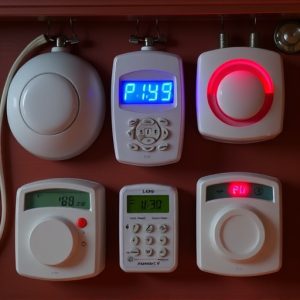Lone Worker Safety: Alarms, Features, & Battery Life for Uncompromising Protection
Lone workers face unique safety challenges, including accidents and getting lost in remote areas. Pe…….
Lone workers face unique safety challenges, including accidents and getting lost in remote areas. Personal Security Alarms with robust battery life are crucial lifelines for signaling help. Modern alarms offer extended battery life, automatic fall detection, and GPS tracking, enhancing safety for isolated workers. When choosing, prioritize devices with loud signals, multiple activation methods, and long battery lifespan, preventing false alarms and ensuring continuous protection in remote locations. Regular testing, training, and clear instructions on PSA usage are essential for maintaining worker safety.
Lone workers, operating independently without immediate supervision, face unique safety challenges. This article explores comprehensive solutions for enhancing their security through safety alert systems, focusing on personal security alarms as a primary risk-mitigation tool. We delve into essential features to consider, emphasizing the critical role of battery life in these devices. Additionally, we discuss best practices to ensure continuous worker safety, providing insights for organizations employing lone workers.
- Understanding the Risks of Lone Worker Operations
- The Role of Personal Security Alarms in Risk Mitigation
- Essential Features to Consider in a Safety Alert System
- Assessing Battery Life: A Key Performance Indicator
- Best Practices for Maintaining Continuous Worker Safety
Understanding the Risks of Lone Worker Operations
Lone workers, by definition, operate independently without immediate supervision. While this autonomy offers numerous advantages, it also introduces distinct safety risks. These risks can range from unexpected accidents to more serious threats like violent encounters or getting lost in remote areas. Understanding these potential hazards is the first step towards implementing effective safety measures.
One crucial aspect of mitigating risks for lone workers is ensuring they have reliable Personal Security Alarms with robust Battery Life. Such devices serve as a vital lifeline, enabling workers to promptly signal for help in case of emergencies. With advanced technologies, modern alarms offer extended battery life, ensuring their reliability when it matters most. This is essential given that prolonged isolation can deplete battery power, and having a low-battery alarm would be counterproductive.
The Role of Personal Security Alarms in Risk Mitigation
Personal Security Alarms play a pivotal role in mitigating risks associated with lone workers, especially in high-hazard industries. These devices serve as a crucial line of defence, providing a quick and effective way to signal for help in case of emergencies. A key factor in their effectiveness is the battery life—a robust alarm should offer extended runtime, ensuring continuous protection even in remote locations where recharging may be impractical or delayed.
With advanced technology, modern Personal Security Alarms boast longer battery lives, sometimes lasting up to several weeks on a single charge. This longevity enables workers to focus on their tasks without constant worry about power sources. Furthermore, many of these alarms incorporate smart features like automatic fall detection and GPS tracking, enhancing the overall safety net for lone workers.
Essential Features to Consider in a Safety Alert System
When selecting a safety alert system for lone workers, several essential features should be at the top of your list. Firstly, consider the personal security alarm functionality—a device designed to deter harm and attract attention when needed. Look for alarms that offer loud, distinct signals to ensure maximum visibility in emergencies. Additionally, devices with multiple activation methods, such as push buttons, voice commands, or automatic fall detection, provide greater versatility and peace of mind.
Another critical aspect is battery life. Opting for a device with an extended battery lifespan ensures consistent protection without constant worrying about recharging. High-quality batteries that offer weeks to months of usage between charges can make all the difference in remote or inaccessible locations where lone workers operate. This feature guarantees reliability and prevents false alarms due to power shortages, ensuring your worker’s safety remains a priority.
Assessing Battery Life: A Key Performance Indicator
When considering safety alert systems for lone workers, assessing the battery life is a crucial aspect that directly impacts personal security. A reliable alarm should offer sustained performance, ensuring the device remains functional throughout its intended use. Battery life serves as a key performance indicator (KPI), reflecting the system’s overall effectiveness and dependability in critical situations. Users need to be confident that their device will not fail when it is needed most.
Lone workers often operate in remote or unpredictable environments, where accessing power sources may be challenging. Therefore, a long-lasting battery is essential to prevent false alarms due to power drain and to ensure continuous protection. Manufacturers should provide clear specifications on expected battery life under various conditions, allowing users to make informed decisions based on their specific needs.
Best Practices for Maintaining Continuous Worker Safety
Maintaining continuous worker safety for lone workers is paramount, especially in remote or high-risk environments. One key practice is ensuring their Personal Security Alarm (PSA) is always fully functional and operational. Regular testing of the PSA’s alarm functionality, battery life, and overall condition should be scheduled at intervals not exceeding every 3 months. This proactive approach enables quick identification and resolution of any issues before they escalate into safety hazards.
Additionally, providing clear instructions on how to use and activate the PSA effectively is crucial. Workers should be trained in emergency procedures and familiarized with the alarm’s range and responsiveness. Regular communication and feedback mechanisms between lone workers and their support teams can further enhance safety by enabling swift response times in case of any alerts or distress signals.
Lone workers face unique challenges, but implementing effective safety alert systems, particularly those incorporating robust personal security alarms and considering critical features like battery life, can significantly enhance their protection. By adopting best practices for maintenance and continuous monitoring, organizations can ensure these systems remain reliable, providing peace of mind and a vital safety net for isolated employees. This proactive approach to worker safety is essential in today’s digital era, where the benefits of technology must be harnessed to navigate labyrinthine risks.


